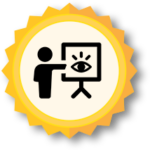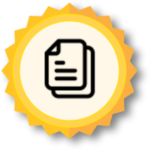Backward Design
 Overview and Introduction: The WHAT and WHO
Overview and Introduction: The WHAT and WHO
When planning a vacation, picking the destination is generally one of the first things done. When building a house, drawing up or selecting blueprints is a typical starting point. Beginning with a destination or vision in mind helps you better plan for that journey or acquire the necessary materials to build that house.
The same process can be used for teaching and learning. This process is commonly referred to as Backward Design[1] since you start at the end and work your way backwards. In an instructional setting, this means you start with the learning objectives. What should learners KNOW after they have completed a lesson? What will the participants be able to DO by the end of the experience?
The key is to write learning objectives in such a way that they can be measured. This will allow to create assessments that measure the attained change in knowledge or performance accurately. Think about how will learners demonstrate their ability to perform the objectives.
Once you have determined the destination, you will have to work backwards and identify ways to get there from where you start! In your teaching, you begin to identify the instructional activities and materials that are needed for learners to complete the learning objective and related assessment task successfully, What materials and interactions will support the learners as they accomplish the objectives?
Backward Design can benefit all involved in the learning and teaching process.
Programs/Institutions
-
- Gain documentation and data that assist in accreditation efforts
- Create solid programs that attract learners
Faculty
-
- Innately focuses their efforts on aligning assessments, activities, and materials that aid students in the attainment of demonstrable knowledge and skills
- Enable learners to successfully meet the learning objectives, and measure learning gain accurately
Students
-
- Recognize the connections between what they are doing and their goals
- Be better prepare for assessments

 Implementation and Timing: The WHEN, WHERE, and HOW
Implementation and Timing: The WHEN, WHERE, and HOW
Backward design is best implemented in the beginning stages of designing instruction. This systematic process helps to ensure the materials developed, activities implemented, and assessments used are all in alignment. This process can be used for any instructional setting, modality, and audience.
Ideas for Implementation [2]:
- Identify the desired outcomes: Begin by clearly defining the specific learning goals and objectives that students need to achieve. These outcomes should be focused on what the learners should be able to understand, know, and do by the end of the instruction.
- Use measurable action verbs: To ensure outcomes are measurable, select verbs that can be measure a performance or knowledge gain overly. Frequently, Bloom’s Taxonomy of Learning is helpful in differentiating various outcomes.
Example: Typical table of contents versus learning objectives that students need to achieve from the contents.
| Table of Contents | Learning Objectives |
| Example: Series Circuits Parallel Circuits Resistive Circuits |
|
- Determine acceptable evidence: Once you have identified the desired outcomes, decide how you will assess whether learners have achieved those outcomes. Consider the formats that produce evidence, such as tests, projects, presentations, and/or lab activities.
- Develop the assessments: Create the assessments that align with the desired outcomes. These assessments should be designed to measure the learners’ understanding and mastery of the knowledge and skills outlined in the outcomes. Ensure that the assessments are valid, reliable, and aligned with the instructional activities.
- Plan the learning experiences: Next, design the learning experiences that will help learners acquire the knowledge and skills necessary to achieve the desired outcomes. Consider the sequence of activities, instructional materials, and resources that will be most effective in supporting their learning.
- Implement the instruction: Deliver the instruction to the learners, following the learning experiences and activities that were planned. To engage all learners, use various instructional strategies, such as lectures, discussions, group work, hands-on activities, or multimedia resources.
- Assess and provide feedback: To gauge the effectiveness of your instruction as well as help learners see their progress, frequently provide opportunities for learners to assess their understanding. Constructive feedback will further guide learners towards achieving the desired outcomes.
- Reflect and refine: After the instruction is complete, reflect on the effectiveness of the backward design process and evaluate the extent to which the desired outcomes were achieved. Depending on your findings, you might consider any necessary adjustments or revisions to improve future instruction.

 Rationale and Research: The WHY
Rationale and Research: The WHY
Clearly defining learning objectives at the start of the design process provides focus and allows for a more efficient planning, implementation, and assessment of learning. Tangible goals ensure alignment between objectives, assessments and instruction. This process increases transparency and centers instruction around student learning[3]. The process of continually connecting the course material and assessment with the core learning objectives help students to be more engaged, by clearly understanding the reason for each activity and its connection with their learning [4].

 Additional Resources and References
Additional Resources and References
[1] J. McTighe and G. P. Wiggins, in Understanding by design handbook, Alexandria, VA: Association for Supervision and Curriculum Development, 1999, pp. 13–34.
[2] Edited from “Implementation steps for backwards design” prompt. ChatGPT, OpenAI, 31, May, 2023, chat.openai.com.
[3] J. Mohammed and K. Schmidt, “Designing a new course using Backward design,” presented at the ASEE 2022 Annual Conference, Minneapolis, MN, 2022.
[4] K. Lulay, H. Dillon, K. Eifler, T. Doughty, D. Anderson, and J. Bastida De Jesus, “Increasing Engagement in Materials Laboratory with Backward Design and Quadcopters,” in 2017 ASEE Annual Conference & Exposition Proceedings, Columbus, Ohio: ASEE Conferences, Jun. 2017, p. 28517. doi: 10.18260/1-2–28517.